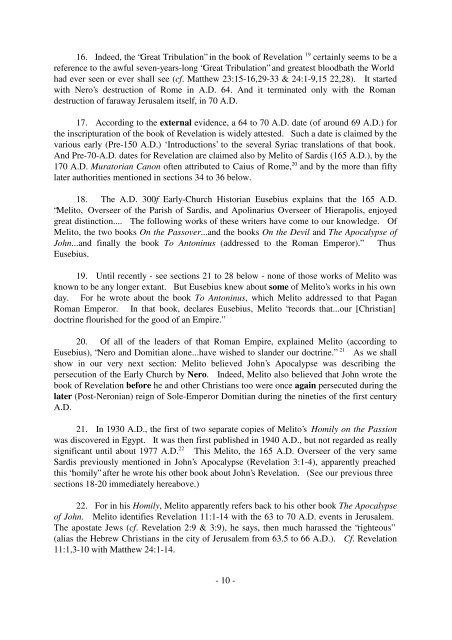JERUSALEM; ROME; REVELATION - The Preterist Archive
JERUSALEM; ROME; REVELATION - The Preterist Archive
JERUSALEM; ROME; REVELATION - The Preterist Archive
You also want an ePaper? Increase the reach of your titles
YUMPU automatically turns print PDFs into web optimized ePapers that Google loves.
16. Indeed, the “Great Tribulation” in the book of Revelation 19 certainly seems to be a<br />
reference to the awful seven-years-long “Great Tribulation” and greatest bloodbath the World<br />
had ever seen or ever shall see (cf. Matthew 23:15-16,29-33 & 24:1-9,15 22,28). It started<br />
with Nero’s destruction of Rome in A.D. 64. And it terminated only with the Roman<br />
destruction of faraway Jerusalem itself, in 70 A.D.<br />
17. According to the external evidence, a 64 to 70 A.D. date (of around 69 A.D.) for<br />
the inscripturation of the book of Revelation is widely attested. Such a date is claimed by the<br />
various early (Pre-150 A.D.) ‘Introductions’ to the several Syriac translations of that book.<br />
And Pre-70-A.D. dates for Revelation are claimed also by Melito of Sardis (165 A.D.), by the<br />
170 A.D. Muratorian Canon often attributed to Caius of Rome, 20 and by the more than fifty<br />
later authorities mentioned in sections 34 to 36 below.<br />
18. <strong>The</strong> A.D. 300f Early-Church Historian Eusebius explains that the 165 A.D.<br />
“Melito, Overseer of the Parish of Sardis, and Apolinarius Overseer of Hierapolis, enjoyed<br />
great distinction.... <strong>The</strong> following works of these writers have come to our knowledge. Of<br />
Melito, the two books On the Passover...and the books On the Devil and <strong>The</strong> Apocalypse of<br />
John...and finally the book To Antoninus (addressed to the Roman Emperor).” Thus<br />
Eusebius.<br />
19. Until recently - see sections 21 to 28 below - none of those works of Melito was<br />
known to be any longer extant. But Eusebius knew about some of Melito’s works in his own<br />
day. For he wrote about the book To Antoninus, which Melito addressed to that Pagan<br />
Roman Emperor. In that book, declares Eusebius, Melito “records that...our [Christian]<br />
doctrine flourished for the good of an Empire.”<br />
20. Of all of the leaders of that Roman Empire, explained Melito (according to<br />
Eusebius), “Nero and Domitian alone...have wished to slander our doctrine.” 21 As we shall<br />
show in our very next section: Melito believed John’s Apocalypse was describing the<br />
persecution of the Early Church by Nero. Indeed, Melito also believed that John wrote the<br />
book of Revelation before he and other Christians too were once again persecuted during the<br />
later (Post-Neronian) reign of Sole-Emperor Domitian during the nineties of the first century<br />
A.D.<br />
21. In 1930 A.D., the first of two separate copies of Melito’s Homily on the Passion<br />
was discovered in Egypt. It was then first published in 1940 A.D., but not regarded as really<br />
significant until about 1977 A.D. 22 This Melito, the 165 A.D. Overseer of the very same<br />
Sardis previously mentioned in John’s Apocalypse (Revelation 3:1-4), apparently preached<br />
this “homily” after he wrote his other book about John’s Revelation. (See our previous three<br />
sections 18-20 immediately hereabove.)<br />
22. For in his Homily, Melito apparently refers back to his other book <strong>The</strong> Apocalypse<br />
of John. Melito identifies Revelation 11:1-14 with the 63 to 70 A.D. events in Jerusalem.<br />
<strong>The</strong> apostate Jews (cf. Revelation 2:9 & 3:9), he says, then much harassed the “righteous”<br />
(alias the Hebrew Christians in the city of Jerusalem from 63.5 to 66 A.D.). Cf. Revelation<br />
11:1,3-10 with Matthew 24:1-14.<br />
- 10 -
















